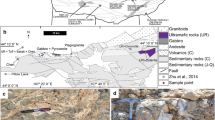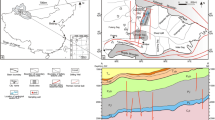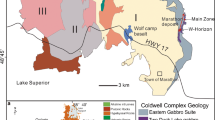Abstract
We present results of a detailed mineralogical and geochemical study of the progressive hydrothermal alteration of clastic sediments recovered at ODP Site 858 in an area of active hydrothermal venting at the sedimented, axial rift valley of Middle Valley (northern Juan de Fuca Ridge). These results allow a characterization of newly formed phyllosilicates and provide constraints on the mechanisms of clay formation and controls of mineral reactions on the chemical and isotopic composition of hydrothermal fluids. Hydrothermal alteration at Site 858 is characterized by a progressive change in phyllosilicate assemblages with depth. In the immediate vent area, at Hole 858B, detrital layers are intercalated with pure hydrothermal precipitates at the top of the section, with a predominance of hydrothermal phases at depth. Sequentially downhole in Hole 858B, the clay fraction of the pure hydrothermal layers changes from smectite to corrensite to swelling chlorite and finally to chlorite. In three pure hydrothermal layers in the deepest part of Hole 858B, the clay minerals coexist with neoformed quartz. Neoformed and detrital components are clearly distinguished on the basis of morphology, as seen by SEM and TEM, and by their chemical and stable isotope compositions. Corrensite is characterized by a 24 Å stacking sequence and high Si- and Mg-contents, with Fe/(Fe+Mg) ratio of ≈0.08. We propose that corrensite is a unique, possibly metastable, mineralogical phase and was precipitated directly from seawater-dominated hydrothermal fluids. Hydrothermal chlorite in Hole 858B has a stacking sequence of 14 Å with Fe/(Fe+Mg) ratios of ≈0.35. The chemistry and structure of swelling chlorite suggest that it is a corrensite/chlorite mixed-layer phase. The mineralogical zonation in Hole 858B is accompanied by a systematic decrease in δ18O, reflecting both the high thermal gradients that prevail at Site 858 and extensive sediment-fluid interaction. Precipitation of the Mg-phyllosilicates in the vent region directly controls the chemical and isotopic compositions of the pore fluids. This is particularly evident by decreases in Mg and enrichments in deuterium and salinity in the pore fluids at depths at which corrensite and chlorite are formed. Structural formulae calculated from TEM-EDX analyses were used to construct clay-H2O oxygen isotope fractionation curves based on oxygen bond models. Our results suggest isotopic disequilibrium conditions for corrensite-quartz and swelling chlorite-quartz precipitation, but yield an equilibrium temperature of 300° C±30° for chlorite-quartz at 32 m below the surface. This estimate is consistent with independent estimates and indicates steep thermal gradients of 10–11°/m in the vent region.
Similar content being viewed by others
Author information
Authors and Affiliations
Additional information
Received: 9 January 1995 / Accepted: 17 June 1995
Rights and permissions
About this article
Cite this article
Buatier, M., Früh-Green, G. & Karpoff, A. Mechanisms of Mg-phyllosilicate formation in a hydrothermal system at a sedimented ridge (Middle Valley, Juan de Fuca). Contrib Mineral Petrol 122, 134–151 (1995). https://doi.org/10.1007/s004100050117
Issue Date:
DOI: https://doi.org/10.1007/s004100050117




